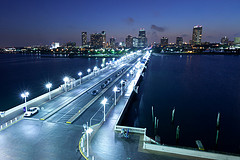By Melissa Beattie-Moss
Research/Penn State

It has been one of Homo sapiens’ most ancient activities: sitting around a fire and gazing with wonder at the stars spread across the dark night sky. These days, if you’ve had this awe-inspiring experience, you’re one of the lucky ones, says Christopher Palma, senior lecturer in Penn State’s astronomy & astrophysics department.
“Did you know that from many locations in the United States you can’t see the whole Little Dipper anymore?” he asks. “Only a few of the stars in the Little Dipper are bright enough to be seen from most of our towns and cities.”
The reason? Light pollution, primarily caused by the widespread use of bright electric lighting over the past hundred years, explains Palma. And not just any lighting—but particularly poorly aimed fixtures that “leak” light up and sideways instead of just illuminating the ground.
Ever since Thomas Edison’s first incandescent bulbs lit up a New York street in 1879, the modern era of electric lighting has been slowly clouding our window to the universe. Almost everyone has observed evidence of this wasted light, Palma adds, such as the luminous halo (dubbed “sky glow”) that hangs over cities and washes out the night sky. The more light pollution, he notes, “the less light you can see from the sky, so less bright objects simply fade from our view.”
Explains Palma, astronomers measure how bright an object is with a unit called a magnitude, and “we measure how bright some area of the sky is in magnitudes per square arcsecond.”
Since the numerical magnitude system is backwards (bright objects are 0 magnitude, faint objects you can see with your naked eye are 6th or 7th magnitude), we refer to the darkest skies as “mag 7 skies,” and very bright skies can be called, for example “mag 2 skies.”
With so many other environmental issues to worry about these days, why should the public care what “mag” rating their sky has?
The impact for astronomers and amateur stargazers is obvious, but research suggests that light pollution impacts the entire natural world. It can alter the foraging areas and breeding cycles of nocturnal animals, and is taking its largest toll on birds that rely on the moon and stars for their bi-annual migrations. For humans, around-the-clock exposure to artificial light is thought to interfere with our sleep, reduce our immune function, and disrupt estrogen and melatonin levels.
Preserving dark skies would help address these problems—and would save energy costs too, says Palma. “The cost of this wasted energy is over $2 billion per year in the U.S. alone,” he explains. In general, “lights that reduce light pollution are more energy efficient than the ones they are replacing, so it’s good for the environment and for all of our budgets.”
Night-sky conservation groups such as the International Dark-Sky Association (IDA) (their motto is “Light what you need, when you need it”) are pushing for change through state, local, and even national lighting ordinances. Says Palma, “I think the IDA has been successful, and will continue to be, because people are starting to realize that dark-sky-friendly lighting is really a win-win. By replacing your light fixtures with dark-sky shielded fixtures, you fix light pollution, help the surrounding ecology, light the area at ground level better, and save energy. What’s not to like?”
And there’s one more benefit to consider, Palma adds. “In every generation up through our parents’ childhoods, everyone could look up at night and see the Milky Way, but today most of us have to go far out of our way to see it. Most American children have never seen the Milky Way.”
“I grew up 30 miles from Manhattan and didn’t know that stars existed until I went to college,” adds Palma. “That’s when I saw the Milky Way for the first time. It made me realize how much of a life-changing effect seeing the beautiful dark sky can have on a person.”
For more Probing Questions and other features about research at Penn State, subscribe to Research/Penn State: http://www.rps.psu.edu/subscribe or follow us on Twitter @PennStateRsrch.
Have an idea for a future Probing Question? Send it along to editor@rps.psu.edu.


